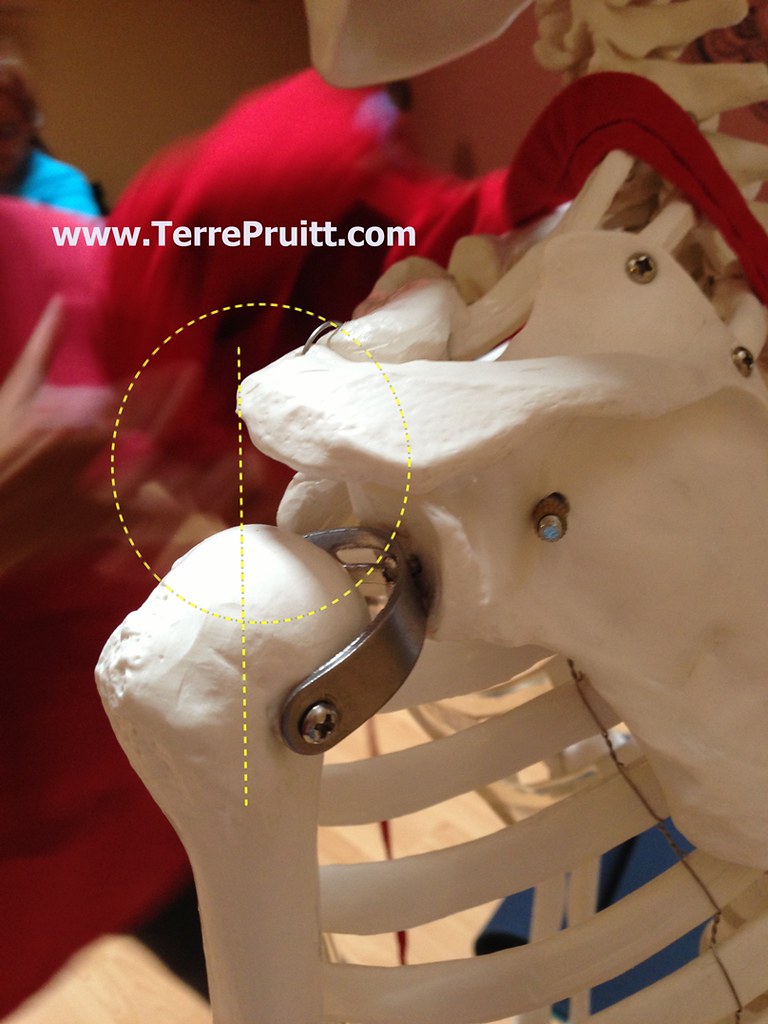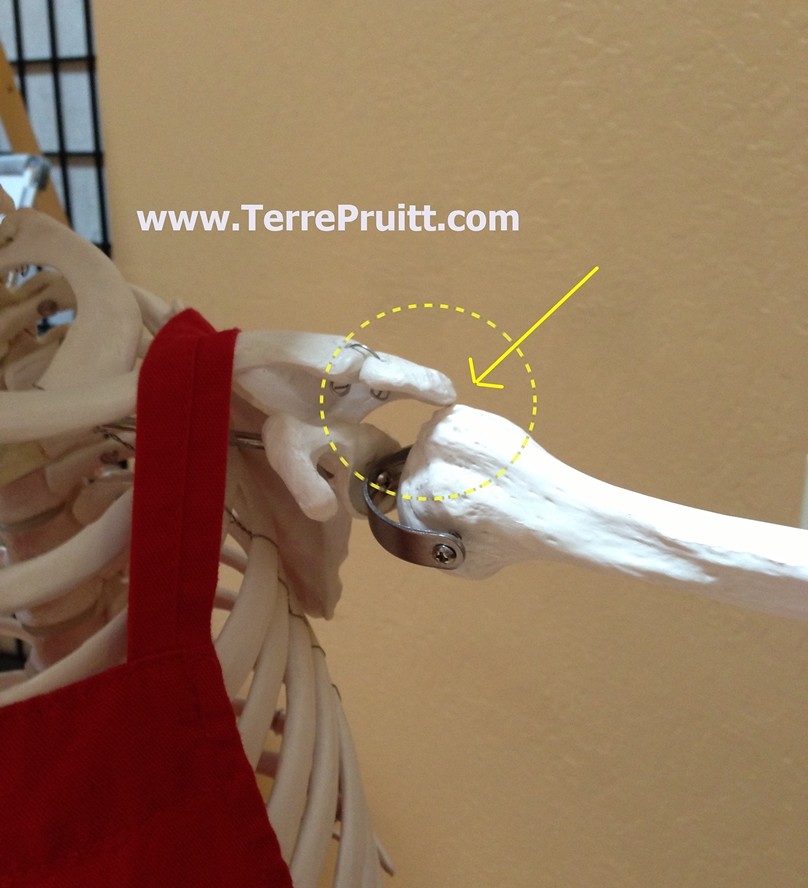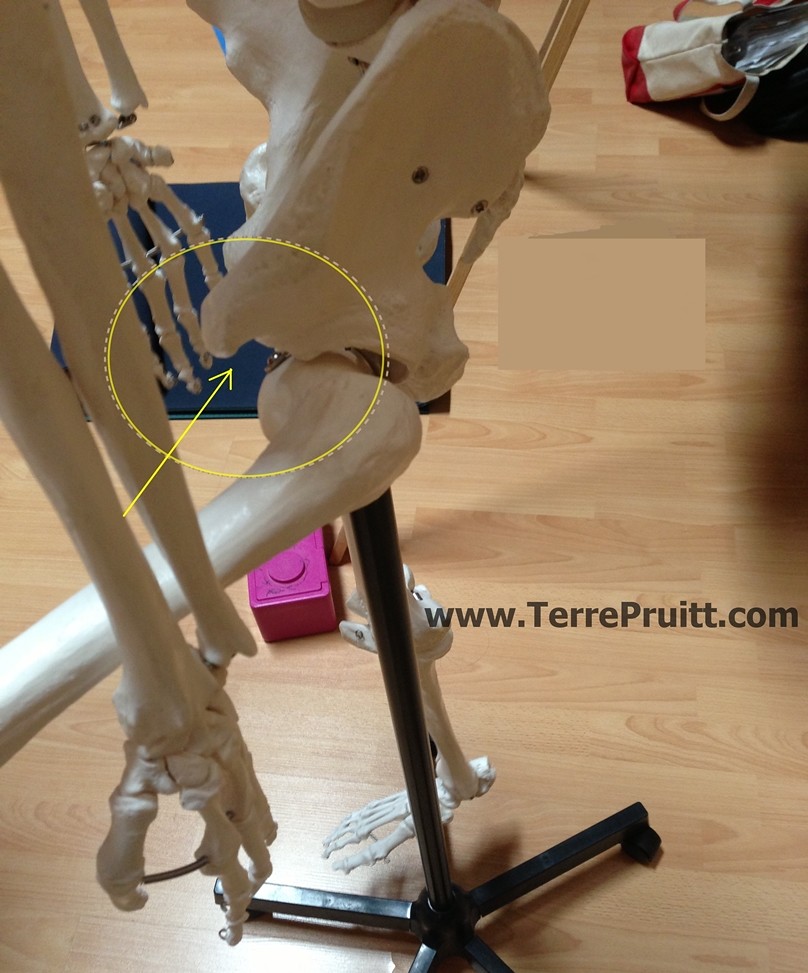Mr. Bones Helps Demonstrate Compression
Posted by terrepruitt on June 30, 2015
 Recently I watched a DVD that wonderfully demonstrated why not everyone can do the poses exactly like the person pictured in Yoga Journal or on a trendy yoga website. The DVD was from Paul Greeley and it addressed compression. While Paul focuses on compression of bone, you will be able to easily conclude there are other types of compression. Compression in mechanics according to Wiki is: “the application of balanced inward (“pushing”) forces to different points on a material or structure . . . .” We are going to say compression occurs when movement of material or structure is to a point where it can no longer move. The movement is stopped because of compression. The DVD’s main point was bones. A bone can only move so far before it contacts another bone. Compression will stop something from moving.
Recently I watched a DVD that wonderfully demonstrated why not everyone can do the poses exactly like the person pictured in Yoga Journal or on a trendy yoga website. The DVD was from Paul Greeley and it addressed compression. While Paul focuses on compression of bone, you will be able to easily conclude there are other types of compression. Compression in mechanics according to Wiki is: “the application of balanced inward (“pushing”) forces to different points on a material or structure . . . .” We are going to say compression occurs when movement of material or structure is to a point where it can no longer move. The movement is stopped because of compression. The DVD’s main point was bones. A bone can only move so far before it contacts another bone. Compression will stop something from moving.
One of the most obvious points of compression is the shoulder. The acromion or acromion process is the bony ridge that is part of the scapula. It extends up and out over the top of the humerus. Or it does on Mr. Bones. You can see the acromion process sticking out and stopping almost halfway over the upper arm bone. But it is not that way in everyone. In some people it could be shorter. In some people it could be longer . . . perhaps extending PAST the humerus. Mr. Bones’ acromion is straight, in some people it could point up or point down. Some people might have an acromion process that twists. Whatever the case may be, the size, length, and projection point of this bony ridge can affect your movement.
S ee how when Mr. Bones’ arm is lifted his humerus comes in contact with his acromion process? That is the compression we are talking about. If the acromion process on Mr. Bones’ was shorter or perhaps pointing upward, his arm could probably be lifted higher up. If the process was longer or pointing down, his humerus would hit it sooner.
ee how when Mr. Bones’ arm is lifted his humerus comes in contact with his acromion process? That is the compression we are talking about. If the acromion process on Mr. Bones’ was shorter or perhaps pointing upward, his arm could probably be lifted higher up. If the process was longer or pointing down, his humerus would hit it sooner.
To put this into a pose example let’s talk downward facing dog. Arms are straight up from the shoulders and hands are above the head. If the acromion were, as in our examples long or pointing down, one would not be able to place their arms above their head while keeping their elbows straight. They might need to bend their elbows to allow the humerus to go around the acromion process so that the arms can be placed above the head.
Another point of compression that is easy to see on Mr. Bones is in his hip area. See how his femur can contact the lower portion of his pelvic girdle? If his femur were set differently the compression would happen at a different angle. The way the long leg bone is set and connected to the hip affects the bend that can be done. The angle of a bend depends on that connection.
A lso, don’t forget, Mr. Bones is JUST bones. He has no muscles, fat, skin, tendons, or anything to get in the way. All that other stuff can add to the compression. Any one of those things that is in the way of the closing an angle would be considered compression.
lso, don’t forget, Mr. Bones is JUST bones. He has no muscles, fat, skin, tendons, or anything to get in the way. All that other stuff can add to the compression. Any one of those things that is in the way of the closing an angle would be considered compression.
Compression is always going to stop the movement, but sometimes compression can be pushed a little. Let’s say there is fat or muscles that is keeping you from going further, sometimes, if it feels right to you, it can be squished a bit. But something like a baby bump should not be squished. Bones might benefit from a little compression, but caution should be used. Sometimes the floor could even play a role in compression. Say you were in a Upavistha Konasana (Wide-Angle Seated Forward Bend) /and you are able to get your head all the way to the floor, but you can’t go any further because of the floor, that could be considered compression.
Paul Greeley’s DVD can be purchased through his site or through Amazon. It really is one of those things that you know, you understand, but sometimes it helps solidify it to see examples. He goes through several poses with his students. The average seemed to be three students per pose so it was very clear as to the different body types and body structures. With the different body types demonstrating, it was clear that not being able to do a pose was not always a case of lacking . . . it wasn’t that they were not strong enough or flexible enough, it could be that their structure affected a pose because of compression. I would highly recommend this DVD to my students.
Does this make sense to you? Did I explain it so that you could understand? When you are practicing yoga are you aware of compression in some poses?
Cheryl McGovern said
Very enlightening! Thanks Terre and hope your summer is going well!
Sent from my iPhone
>
LikeLike
terrepruitt said
It is really cool to SEE the different body types all doing the same pose.
My summer is going well, thanks. I hope you are staying happy and healthy! XO
LikeLike
Joy Wilner said
I like doing the poses the way that feels good to me. It’s turns out that many women got sacroiliac joint issues from doing “perfect” Iyengar Yoga poses, which were really created for people with narrow hips. I think Iyengar Yoga is out of fashion, but altering photos to make women look thinner has become very popular.
That’s interesting about the acromion process. I knew that our body types, connective tissue and muscles differed greatly, and that we move differently as a result. I didn’t know that the acromion process could vary too.
LikeLike
terrepruitt said
Hello. Originally when I first heard of yoga I believe it may have been Iyengar and I was not interested because it was so strict. When I finally got into yoga it was with the mindset that bodies need to do what bodies can do not what something says they should do. I love that yoga is now accessible to many bodies. I think most of us are aware that bodies are different, but for some reason when it comes to yoga there are some people that “beat themselves up” because they can’t get into a certain pose so I use Mr. Bones and Paul Greeley’s work to remind us that we are all put together differently. Paul’s videos are really cool because you see all size and types of bodies able to and UNable to get into poses. His video’s show how all kinds of things can restrict movement. I am so glad you learned something. I know that you have done a lot of study about the body and movement, so it is nice to be able to share something new. Thank you so much for taking time to read and comment, Joy!
LikeLike